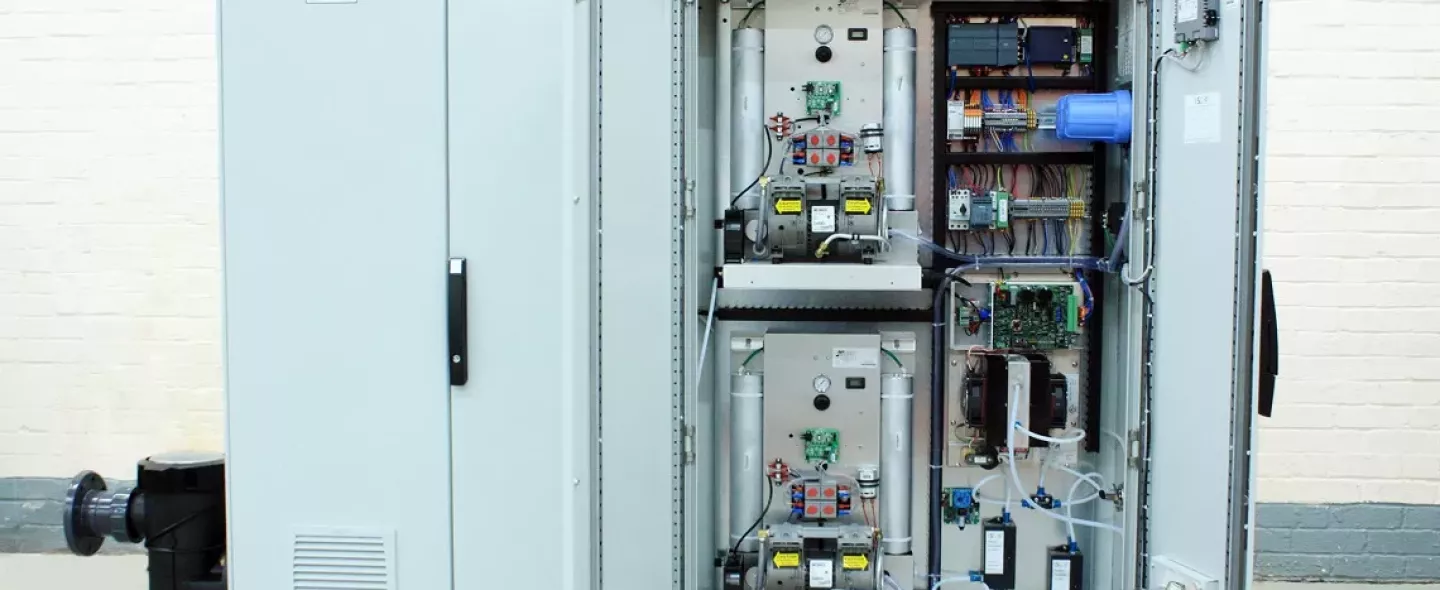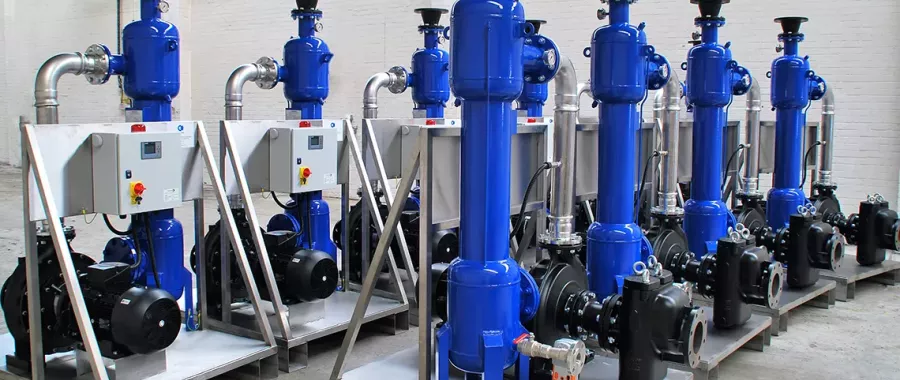SOCOTEC provides a range of water treatment services using Ozonated water as a disinfectant.
Ozone Water Treatment FAQs
An inorganic molecule, Ozone (O3) is an allotropic form of oxygen (meaning it exists in two or more different forms). Each molecule contains three atoms of oxygen instead of the standard two, which is why Ozone is also scientifically known as trioxygen. It takes the form of a pale blue gas which is formed naturally in the atmosphere and has a pungent odour.
Ozone is formed by lightning discharges during a thunderstorm, which gives the air its characteristic fresh and sharp smell afterwards (similar to that of chlorine).
In the same way that Ozone is formed naturally by the discharge of electricity during a thunderstorm, large quantities of Ozone are produced in a modern electrical Ozone generator. This method of Ozone generation is formed by corona discharge, where a high voltage is passed across a gas stream containing oxygen. The energy of the high voltage splits an oxygen molecule (O2) into two oxygen atoms (O), which recombine with ordinary molecules of oxygen (O2) to form the Ozone chemical formula (O3).
To improve the performance of the Ozone generator, pure oxygen can replace the ambient air, providing a greater percentage of oxygen in the airstream. Ozone can also be formed within the proximity of certain types of ultraviolet lamps – however, this will only produce ozone at low concentrations. Since Ozone is highly reactive and has a short half-life, it is very difficult to store and transport. It must therefore always be generated on site for immediate use.
Ozone is a powerful oxidising agent which, when dissolved in water, produces a broad spectrum biocide that destroys all bacteria, viruses and cysts. Ozone water treatment has been used commercially for the treatment of potable water since 1904.
Ozone is the most powerful oxidising agent permitted for use in water treatment (only fluorine is stronger and its use is banned in most countries). It is capable of destroying all bacteria, algae and biofilms within water systems, with no risk of resistance build-up or immunity. Aqueous Ozone has a proven track record of readily and rapidly eliminating 99% of known viruses, including resistant and problematic aqueous microorganisms (such as Giardia, Cryptosporidium, Streptococcus Faecalis and E. coli), all of which are renowned for causing grave human health concerns in potable water.
As an oxidising agent, Ozone is 51% stronger than chlorine and has a kill rate of 3.125 times faster. Ozone owes its biocidal effectiveness to its ability to oxidise organic material in bacterial membranes, which weakens the cell wall and leads to cell rupture, causing the immediate death of the cell. In contrast, chlorine and all other oxidising and non-oxidising biocides must be transported across the cell membrane in order to interfere with either the nuclear reproductive mechanism or various enzymatic life providing reactions in the cell, resulting in substantially less biocidal efficiency in either event.
For this reason, Ozone is capable of destroying all bacteria, algae and biofilms, with no risk of resistance build-up or immunity. Even resistant and problematic aqueous micro-organisms, such as Giardia, Cryptosporidium, streptococcus fecalis and E. coli (which cause grave human health concerns in potable water) are readily and rapidly inactivated by Ozone. Although viruses are more resistant to Ozone destruction compared to bacteria, viral inactivation occurs more readily with Ozonation than it does with halogenation.
Yes, oxidation is a natural process and eliminates the need for chemicals. Ozone water treatment has been used around the world for many years, with major food and beverage companies relying heavily on the technology. Ozone disinfection is also commonly used within swimming pools.
Ozone is a highly reactive substance, and uncontrolled exposure can lead to severe respiratory illnesses, such as lung damage and irritation of the upper airways. Nevertheless, though the production of Ozone is toxic, it is completely safe when used as a means of water treatment.
Ozone is listed as an oxidising biocide in the ACoP L8 regulations and has been formally tested by the US Department of Energy, who have confirmed its effectiveness as a biocide.
Ozone is highly reactive, with a very short half-life once it has dissolved into water. The natural reaction for Ozone (O3) is to return to its oxygen form (O2), with the reaction time typically 10-20 minutes at 20ºC. This means that any bleed from an Ozone-treated non-ferrous cooling system will not contain any chemical biocides, corrosion inhibitors or toxic residues. This means that it will not be classed as effluent and may be disposed to surface drainage.
Ozone has a neutral pH (about 7.0), so it does not affect the pH of the system's water. It has no calcium or alkalinity and no dissolved solids, and therefore will not affect water balance. Ozone does remove trace amounts of dissolved metals such as iron, manganese and copper by oxidising them to their highest oxidation state. They will then precipitate out of the water and be removed by filtration.
Due to its short half-life, Ozone will start to decay as soon as it is produced. Lasting an average of 20 minutes in the water before it begins to decay, Ozone concentration will reduce by half within this time period.
When correctly applied, Ozone has been proven to maintain minimal corrosion rates (similar to and frequently better than) systems treated with traditional chemicals. It is, however, most important to consider all system components when selecting Ozone as your product of choice, and SOCOTEC can advise with this selection.
While it is often only thought of as a disinfectant, Ozone actually has a multitude of uses. With a broad range of oxidising capabilities and environmental benefits, Ozone has the following advantages:
• Reducing the need for chemicals – as the Ozone gas is produced ‘in situ’, there are no storage or
transport costs
• No pollutants – the only ‘breakdown’ product is oxygen
• Any wastewater is safe to re-enter waterways and surface drains, saving energy and money
• A huge reduction in most CIP (Cleaning in Place) processes
• Wastewater can be used in other grey water applications, saving water top up from other sources
• Negating the use of harmful halogens such as chlorine and chlorine dioxide
• No chemical manufacture is required, therefore reducing the need for transport and eliminating the need
for chemical drums
• Immediate elimination of risk of running out of chemical stock and delivery complications etc.
The horticulture industry is now strongly reliant on Ozone, which is a much stronger disinfectant compared to chlorine and other chemical-based alternatives. Despite this, Ozone is safe for plant nutrients, with tests showing that Ozone does not affect phosphorus and potassium levels. As a powerful oxidiser, Ozone destroys fungi, pathogenic bacteria and viruses which cause waterborne diseases.
Ozone has been used for over 100 years as a preservative for foods and food ingredients, as well as for purification in the brewing industry, odour control and medical therapy. It is capable of destroying all bacteria algae and biofilms, with no risk of resistance, build-up, immunity or toxic residues, making it an ideal choice for direct food and drink applications.
Ozone is also a strong sanitisation and fumigation agent, which can be used to sanitise foods in the storage room and during shipping to prevent bacteria, mould and yeast on the food surface and to control insects. It can eliminate undesirable flavour produced by bacteria and chemically remove ethylene gas to slow down the ripening process, allowing extended distribution.
General practice for cleansing fresh fruits and vegetables requires washing in Ozonated water, and the wash water is then recaptured and treated by filtration and Ozonation. The treated wash water is free of bacteria, colour and suspended solids and can be recycled to reduce water usage. Unlike conventional halogen-based washing systems, wastewater discharged by the Ozonation process is free of chemical residuals, which pose a growing concern in terms of environmental and groundwater pollution.
Ozone is also commonly used to disinfect bottled drinking water, as it is both soluble and effective at killing microorganisms via the oxidisation of their cell membranes. It also has the unique property of auto-decomposition and will leave no toxic residues behind. This feature gives bottling plants the opportunity to disinfect drinking water and extend shelf life without chemically adding to the process water.
The Biocidal Products Regulations (EU) 528/2012 (BPR) came into force on 1 September 2013, repealing the Biocidal Product Directive (Directive 98/8/EC) from this date. From 1 September 2013, Ozone is regulated as an ‘active substance’ under the BPR.
Under the BPR, anyone who wishes to market an Ozone generator for a Biocidal application within the EU must have their product authorised in accordance with the BPR. SOCOTEC is a founding member of the European Ozone Trade Association (EUOTA), which has submitted its dossier to the Biocide Products Regulations body.
• Water purification
• Drinking and bottled water
• Swimming pools
• Industrial wastewaters
• Cooling towers
• Adiabatic cooling water for data centres
• Groundwater remediation – reduction/elimination of algaecides and pesticides
• Helping clients to meet Environment Agency effluent targets
• Wastewater re-use
• Decolourisation
• Destruction of ozone, chlorine and other oxidants
• Organic synthesis
• Aquaculture and fish farming
• Manufacture of pharmaceuticals and beauty products
• Food processing and preservation
• Rinsing water
• Surface treatment – semiconductor manufacture and inorganics production.
Ozone concentration levels in the water can be measured via an Ozone meter, which is available for purchase via SOCOTEC’s online Shop.



